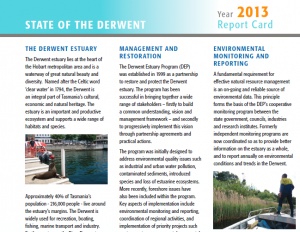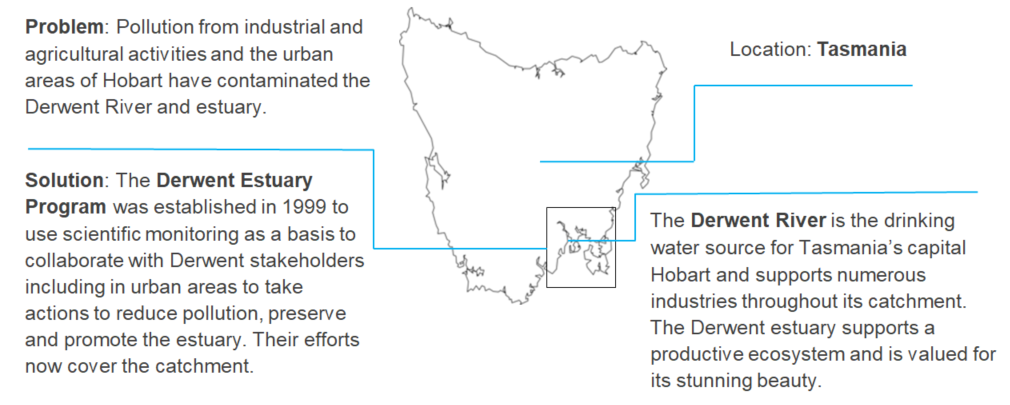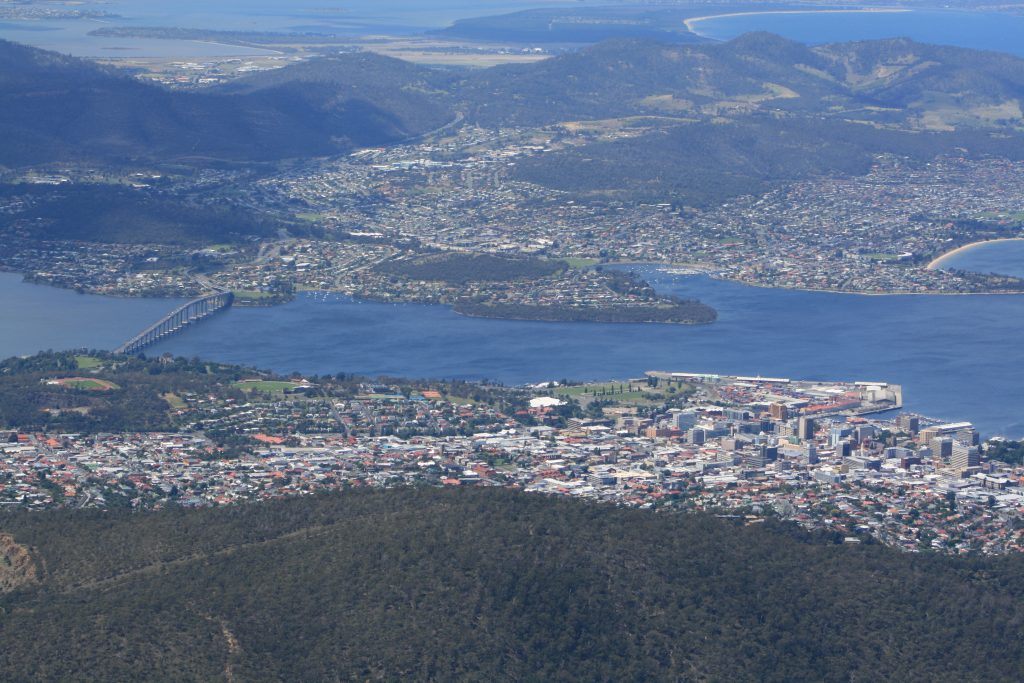Data-driven collaboration: Activating estuary and catchment stakeholders through scientific monitoring to take actions to reduce pollution
Today, 200 000 people, the equivalent of 41% of Tasmania’s population, reside around the Derwent estuary. Furthermore the upstream reaches of the Derwent River support industry, agriculture and hydroelectricity production. Due to the multiple uses of the river and polluting activities, the once diverse and rich habitats of the estuary and coastal areas have been negatively impacted. In the absence of stringent catchment level environmental protection policies to protect the quality of water resources; Tasmanians looked towards a multi-stakeholder and science-driven approach to monitor environmental health in the Derwent Estuary and activate stakeholders contributing to poor water quality to actively take actions to reduce their impact and remediate the estuarine environment.
The Derwent Estuary Program (DEP) was established in 1999 to protect and promote the estuarine environment using data and information as a basis to foster collaboration with key stakeholders negatively impacting the health of the estuary. The DEP is slowly expanding this approach to include the Derwent catchment in their program. Transparent environmental reporting supported by data identifies a stakeholder as negatively contributing to the health of the estuary and river. The DEP uses this as an opportunity to collaboratively craft solutions to limit sources of pollution. The ultimate goal is to achieve complete environmental monitoring of the catchment. This would support decision-making that protects the quality of water resources and offers a platform to integrate water management efforts across stakeholders at the catchment level.
1. The Problem
The estuarine habitat of the Derwent River is a prized ecosystem for the residents of Tasmania’s capital city, Hobart. Common to many estuaries situated near cities and at the mouth of rivers subject to industrial activity, water quality is a key issue in the Derwent estuary. Pollution entering the estuary originates from both point and diffuse pollution sources[1]. Point sources of pollution have been identified, where industrial operations and effluent, treated sewage effluent (high nutrient content) are contributing to poor water quality. Diffuse pollution sources include urban storm water runoff and runoff from the wider catchment and from landfills and contaminated sites. Pollution from aquaculture operations; marina and shipping activities are also negatively contributing to poor water quality. Due to the particular hydrodynamics of the Derwent estuary, pollutants tend to become widely distributed throughout the estuary[2], making widespread environmental monitoring the key to understanding the estuarine system. Importantly, the Derwent River is the drinking water source for Hobart. The river is essential for industrial activity along the river and provides recreational and cultural services to all those living along its shores.
The Derwent catchment has 10 hydroelectric power stations[3], thus the river flows in the Derwent catchment are no longer natural. Changes in flows have become significant in recent times, as climate variability has caused drought spells, as well as flooding spells. Such seasonal and annual variations in precipitation and temperature impact water quality indicators, as well. Climate variation has also been one factor that has made it difficult to assess changes in the short-term, through, for example, the annual report cards[4].
2. The solution – Building a coalition of the willing through the Derwent Estuary Program
The Derwent Estuary Program (DEP) started in 1999 and originally focused on preserving and enhancing the estuarine habitat and improving its water quality, but it has now grown and the program seeks to work with others on initiatives throughout the catchment. The aims of the DEP are:
- Coordinate initiatives to reduce pollution
- Conserve habitats and species
- Monitor river health
- Promote greater use and enjoyment of the foreshore
The DEP has been an advocate of sound environmental monitoring since its inception. Their model for building collaboration is always, understand the science first, and then apply initiatives through collaboration. It is in this way that the actors responsible for activities contributing to poor water quality or poor river health can be identified and brought on board as collaborating partners. The DEP itself has limited capacity to undertake its mandate, therefore partnerships are essential. As the activities of the DEP and the cost of actions to improve water quality are resource intensive, it is critical that partnerships are not simply symbolic, but are financial partnerships. When money is on the line, projects get moved forward.
Although there are many environmental issues that are affecting the Derwent catchment, the entry point into tackling any of these issues is science and environmental monitoring. Through a sound understanding of the estuarine environmental dynamics and catchment dynamics, two initiatives have proven quite successful:
- Manage and reduce pollution (nutrients, heavy metals, stormwater)
- Improve water quality at beaches (popular beaches with ‘no swimming’ advisories)
Photo: Diego Delso [CC BY-SA 3.0 (https://creativecommons.org/licenses/by-sa/3.0)], via Wikimedia Commons
2.1 Partners
In Tasmania, there is no regulatory framework that allows for an integrated catchment approach for environmental regulation. Over the years, the DEP has worked very hard to build a strong reputation based on credibility and transparency. In this way, partners that work with the DEP also benefit from enhanced credibility and improved public image. Current partners include:
- City councils (Brighton, Clarence, Derwent valley, Glenorchy, Hobart, Kingborough)
- Tasmanian state government
- Water utility (TasWater)
- Energy utility (Hydro Tasmania)
- Tasmanian Ports Corporation
- Industry (Norske Skog Boyer, Nyrstar Hobart)
- Other project partners include: the Australian Government, University of Tasmania, CSIRO, NRM South, local businesses and community groups.
2.2 Key partnership activities
Water utility: TasWater
The DEP partners with the water utility, TasWater, since they have been identified as a key source of nutrient flows from treated sewage effluent. In response, TasWater have been working towards recycling treated sewage effluent for agricultural irrigation. As stronger scientific data becomes available identifying TasWater as a key contributor to excess nutrients in the Derwent river, TasWater can expand the scope of investment plans to scale up recycled water from treated wastewater for irrigation.
TasWater is also interested to support actions that reduce the flow of nutrients from further upstream in the catchment, as this results in algal blooms, causing higher cost for drinking water treatment and taste issues in the treated water. TasWater is a critical partner in environmental monitoring for the DEP, as they have 30 scientists on their staff that can contribute to data collection and analysis.
Municipal: Hobart City Council
Tackling aging piped infrastructure in Hobart is critical to reduce harmful microbial and pathogenic pollution being released into beach waters. For example, after severe rain events, residents are advised to avoid swimming at the coastal beaches for 2 days due to storm water overflow into beach waters[1]. Aging infrastructure including occasional illegal connections contribute to the problem and it is a slow process to rectify, but will improve water quality at popular beaches. Further investments will be needed to upgrade storm water infrastructure in Hobart and the DEP would like to support city councils to tackle this issue by implementing more water sensitive urban design features in urban areas[2]. The DEP has also developed the BeachWatch initiative[1], to regularly communicate with Hobart’s resident’s the quality of water at popular beaches through signage and to ensure that residents do their part to ensure they do not contribute to poor water quality at beaches.
Industry: Nyrstar Hobart and Norske Skog Boyer
It has been critical to bring industrial partners on board to support the DEP, as they have historically been the largest point source contributors of heavy metal and organic material to the Derwent River. For instance, Norske Skog paper mill used to be a key contributor of organic material to the Derwent River, which is problematic for river and estuary health. The decomposition of organic material reduces biologically available oxygen in water, which creates favorable conditions for heavy metals to mobilize and be carried further downstream. Through the DEP partnership, Norske Skog has invested in reducing organic loads released into the Derwent from its activities, achieving reductions of almost 95% since 2011[1].
Heavy metals are a major concern for ecosystem and human health in the Derwent catchment. Heavy metals are present in river sediments and have bioaccumulated in larger freshwater fish and shellfish[1]. Nyrstar Hobart is a zinc smelter and is an important partner for the DEP to reduce heavy metal pollution. Through partnering with the DEP, Nyrstar Hobart has successfully managed to capture and treat all storm water reaching the Derwent from its smelter. They have also managed to collect and treat groundwater that has been contaminated with zinc, removing up to 140 tonnes of zinc and other contaminants per annum since 2012[1].
3. Outcomes
3.1 Challenges
Although the DEP has positively impacted the Derwent ecosystem; it has been a slow and steady game of patience and using science to initiate conversations with current and prospective partners. The DEP is now seeking to extend this approach further upstream in collaboration with city councils; industries; utilities and communities located near the estuary and river. The diverse number of stakeholders impacting the Derwent River includes those from agriculture (dairy, fish, cattle, fruit and vegetable producers)[1], forestry companies and numerous private land-owners. The program expansion will start with a two year monitoring program that is supported by multiple stakeholders which will be a basis for informed debate. In addition to monitoring, the DEP are also working with a range of catchment stakeholders through DEP partners to develop a water quality improvement plan based on modelling, science and communication. The solutions to pollution control in the catchment aren’t novel, but they must be crafted based on sound data and necessitate financial partnerships and working with communities to streamline initiatives. The first step always requires that time and resources be invested in environmental monitoring to establish baseline data, as this forms the scientific backbone from which financial partnerships can be forged and an integrated management plan can be devised.
3.2 Improvements, what is next?
Data and environmental monitoring is the bedrock of the DEP. Currently, the DEP is working with its partners to update the previous 20 years of data that is already on record. This will be important to assess what has worked in the past and increase understanding of the catchment system. The DEP is well aware that they will discover new challenges and will need to work with a wider range of stakeholders as their understanding of the catchment system increases. They see this as an opportunity to address the problem.
3.3 The success of the Derwent Estuary Program

Figure 1 The State of the Derwent Annual Report Cards are an important medium for raising the profile of the DEP. Image taken from DEP.
Alongside a commitment to building a program based on science, the DEP can only be effective through collaboration. It is through financial partnerships, especially with industry that heavy metal pollution entering the Derwent estuary has been reduced by over 50%[2].
Collaboration and transparency has been more successful than waiting for environmental regulations to trigger integrated management. The DEP has successfully been able to build a solid reputation with the communities sharing the Derwent foreshores. The program helps to answer very relevant questions: Can I eat this fish? Can I bathe at this beach? Transparency in communicating the health of the waterway through their annual report cards has helped to raise the profile of the program, as this attracts media coverage and issues of concern are highlighted just as much as the program’s successes.
Regular reporting based on updated data is essential for keeping the motivation of partners and communicating with the public (annual report cards1, 5-yearly State of Derwent Reports1, environmental management plans2, technical reports[1], newsletters8, community education resources[2]). The DEP also has a peer review process prior to publishing the results of updated environmental monitoring. For example, if the data shows that nutrients from treated wastewater effluent are on the rise and contributing to algal blooms further downstream, then the DEP will share this with TasWater prior to publishing the data. This creates a positive space for the DEP and TasWater to have a constructive conversation about how they can best up-scale recycling of effluent from wastewater treatment, for example. In any case, the data will be made public.
The story of the Derwent Estuary Program demonstrates how collaboration across the catchment mediated through transparent environmental monitoring can restore and promote the health of an estuary and, hopefully an entire catchment. Their case is rather unique due to the small scale, but other islands, communities and cities may be able to tailor the Derwent approach to their own specific cases.
4. Useful links
State of Derwent: Year 2013 Report Card. Available at: https://www.derwentestuary.org.au/assets/ReportCard2013_FINAL.pdf
Derwent Estuary Program Environmental Management Program – February 2009. Available at: https://www.derwentestuary.org.au/assets/Final_EMP_2009.pdf
Hydro Tasmania. 2017. Derwent. Available at: https://www.hydro.com.au/energy/our-power-stations/derwent
Derwent Estuary Program. 2016. Report Cards. Available at: https://www.derwentestuary.org.au/report-cards/
Derwent Estuary Program. 2016. BeachWatch. Available at: https://www.derwentestuary.org.au/beach-watch/
Tasmania’s Sustainable Agri-Food Plan 2016-2018. Available at: http://dpipwe.tas.gov.au/Documents/Agri-Food%20Plan%202016-2018.pdf
Derwent Estuary Program. 2016. Reports and Publications. Available at: https://www.derwentestuary.org.au/reports-and-publications/
Derwent Estuary Program. 2016. Educational Resources. Available at: https://www.derwentestuary.org.au/educational-resources/
Derwent Estuary Program. 2016. Available at: https://www.derwentestuary.org.au/
Key Words
| Tasmania | Collaboration | Environmental monitoring |
| Water quality | Estuary | Ecosystem |
| Partnership | Governance from catchment to tap | Derwent |



